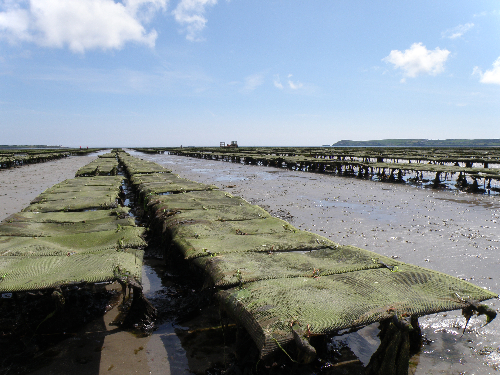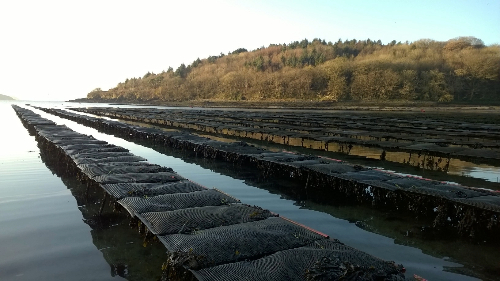Using whole genome sequencing to track the spread of Vibrio infections in farmed oysters across Europe
Posted on September 4, 2023 by Dr Nicola Coyle and Professor Edward Feil
Dr Nicola Coyle and Professor Edward Feil take us behind the scenes of their latest publication, 'Vibrio aestuarianus clade A and clade B isolates are associated with Pacific oyster (Magallana gigas) disease outbreaks across Ireland' published in Microbial Genomics.
Just as whole genome sequencing (WGS) has proven transformative in tracking the spread of human pathogens on both local and international scales, the same technology and analytical techniques can provide a powerful approach to mitigating infectious disease in farmed animals. Genomic epidemiology is thus not only a central tool for protecting public health, but also the management of animal pathogens which is critical for maintaining economic welfare and food security. In particular, the implementation of WGS for the management of aquaculture pathogens has shed light on disease provenance and aetiology, the prevalence and mechanism of antibiotic resistance, virulence and the impact of vaccination programs (Bayliss et al. 2017). Here we present a project where WGS was applied for the first time to specifically provide insight into pathogenic Vibrio associated with disease in the Irish oyster industry.

Our study represents a collaboration between the Bacteriology team in the Centre for Environment Fisheries and Aquaculture Science, Cefas, Weymouth, UK, the Fish Health unit at the Marine Institute, Ireland and the Feil group at the University of Bath, UK. These researchers used WGS to provide international epidemiological context to disease outbreaks among farmed Pacific oysters (Magallana gigas) in Ireland. This industry began in Ireland in the 1970’s and expanded throughout the 2010’s with production now over 10,000 tonnes per year, and a value of over €44 million. Substantial losses of stock in Ireland have resulted from outbreaks of a disease called summer mortality syndrome and similar outbreaks were being reported in France. Whilst this is a complex infection of mixed aetiology, it is known to be commonly associated with the presence of Vibrio species, and in particular a recently emerged subspecies V. aestuarianus spp. francensis which appears to have evolved pathogenic traits specific to oyster hosts. There are close trade links between the Irish and French oyster industries, so a key question we had was to compare the isolates responsible for outbreaks in the two countries. Vibrio isolates were therefore sampled and sequenced from oyster farms across Ireland and compared to previously characterised samples from France and elsewhere in Europe.
The WGS data confirmed a predominance of V. aestuarianus spp. francensis bacteria belonging to the same two strain sub-groups that were known to be causing disease in France (identifed by Goudenège et al. 2015), and are spreading to other farms across Europe (identified by Mesnil et al. 2023). The identification of specific high-risk sub-groups provides the basis for the targeted surveillance and intervention strategies, and future studies on the evolution and pathogenicity of these strains. We therefore recommend in this paper for the deployment of WGS to characterise isolates from oyster disease outbreaks, particularly in regions where these have not yet been characterised in detail.

We would also like to highlight the added value of using long-read technology for future WGS analysis of V. aestuarianus. During the review process it was noted that genomes assembled using short reads were consistently more fragmented than for other Vibrio isolates within the same study, despite having higher coverage. Mensil et al. (2023), used a mixture of long and short read sequencing to study this species. Together, findings from their study along with ours suggest that V. aestuarianus is challenging to assemble with short reads. Long-read sequencing on the other hand yielded high quality assemblies, allowing the authors of Mesnil et al. to study the genome in greater detail. One fascinating discovery they described as a result of this was the presence of significantly higher numbers of insertion sequences in lineages of Vibrio aestuarianus associated with pathogenicity. Thus, long-read analysis is not only useful for obtaining more accurate assemblies in this species, but also allows for more in-depth evolutionary analysis.
V. aestuarianus was not the only species to be isolated from the Irish oyster samples, there was also a high frequency of isolates belonging to the V. splendidus species complex. The data highlights the complex taxonomy of this group and the difficulties in species assignment. V. splendidus is highly diverse and freely recombining, and it is rare for two isolates to be clonally related. It was therefore unexpected to observe a single V. splendidus clone, represented by closely related isolates, widely disseminated across the Irish farms. As many of the sites involved had received oysters from a single source, it is likely that this clone has spread through the movement of oysters. This example highlights how the trading practice of farmed animals can facilitate the spread of the bacteria that colonise and infect them.

The collaborative effort described in this study represents the first endeavour towards using WGS to understand Vibrio pathogens in the Irish oyster industry. Collectively the comparisons made against previously sequenced isolates for each species provide an excellent example of how genomic data can be used to place local outbreaks within an international context and the importance of freely accessible and geographically representative databases.
Thumbnail image credit: Dr. Evelyn Collins
References
Bayliss, Sion C., David W. Verner-Jeffreys, Kerry L. Bartie, David M. Aanensen, Samuel K. Sheppard, Alexandra Adams, and Edward J. Feil. 2017. “The Promise of Whole Genome Pathogen Sequencing for the Molecular Epidemiology of Emerging Aquaculture Pathogens.” Frontiers in Microbiology 8 (February): 121. https://doi.org/10.3389/fmicb.2017.00121.
Goudenège, David, Marie Agnès Travers, Astrid Lemire, Bruno Petton, Philippe Haffner, Yannick Labreuche, Delphine Tourbiez, et al. 2015. “A Single Regulatory Gene Is Sufficient to Alter Vibrio aestuarianus Pathogenicity in Oysters.” Environmental Microbiology 17 (11): 4189–99. https://doi.org/10.1111/1462-2920.12699.
Mesnil, Aurélie, Maude Jacquot, Céline Garcia, Delphine Tourbiez, Lydie Canier, Audrey Bidois, Lionel Dégremont, et al. 2023. “Emergence and Clonal Expansion of Vibrio aestuarianus Lineages Pathogenic for Oysters in Europe.” Molecular Ecology, March. https://doi.org/10.1111/mec.16910.

